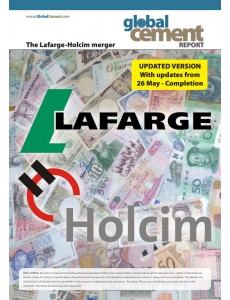
The Lafarge-Holcim merger
Price:
£150.00
This report examines the effects of the LafargeHolcim merger worldwide and in each of the countries that the company is present.
When Lafarge and Holcim merged to form LafargeHolcim in July 2015, they created the largest multinational cement producing company in the world by installed capacity, with control of around 340Mt/yr of cement production capacity. Active in 62 countries, LafargeHolcim is present in a total of 18 European countries (59.2Mt/yr of cement capacity). It is active in three countries in North America (36.2Mt/yr), eight in South America (20.8Mt/yr), 21 in Africa and the Middle East (64.4Mt/yr) and 12 in Asia (169.8Mt/yr).
As has been known for many months, assets will have to be sold in some jurisdictions in order to allow approval by the relevant competition authorities. The Lafarge-Holcim merger report therefore outlines the 'before and after' financial situations and geographic footprints of Lafarge, Holcim and LafargeHolcim globally and locally, quantifying changes to their global interests and market shares in each individual country in which either Lafarge or Holcim currently has a cement industry presence.
The LafargeHolcim position will be unchanged relative to the prior Lafarge or Holcim positions in 44 countries due to there being only Lafarge or Holcim assets in those countries before the merger. LafargeHolcim will have to sell selected assets in 10 countries in which both Lafarge and Holcim currently operate, due to competition concerns. It will take on the full assets of Lafarge and Holcim in eight countries but will also depart three markets in which Lafarge or Holcim had cement-making assets prior to the merger.
Contents
Executive summary
List of Figures and Tables
Company introductions
Merger background
Second quarter of 2014
Second half of 2014
The story so far in 2015
Pre-merger situations
Finances and production in 2013
Finances and production in 2014
Comparison of finances and production
Comparison of geographical coverage
Geographical coverage by subsidiaries, joint-ventures and associates (2014)
Comparison of alternative fuels
Staffing levels and costs
Global cement industry before the merger
Largest global cement companies
Most prolific cement-producing nations
Nations with largest cement capacities
The merger in different countries
Algeria, Argentina, Australia , Austria, Azerbaijan, Bangladesh, Belgium, Benin, Brazil, Bulgaria, Cameroon, Canada, Chile, China, Colombia, Costa Rica, Croatia, Czech Republic, Ecuador, Egypt, El Salvador, France (inc. Overseas Departments), Germany, Greece, Guinea, Hungary, India, Indonesia, Iraq, Italy, Ivory Coast, Jordan, Kenya, Lebanon, Malawi, Malaysia, Mexico, Moldova, Morocco, New Zealand, Nicaragua, Nigeria, Pakistan, Philippines, Poland, Romania, Russia, Saudi Arabia, Serbia, Slovakia, South Africa, South Korea, Spain, Sri Lanka, Switzerland, Syria, Tanzania, Thailand, UAE, Uganda, UK, USA, Vietnam, Zambia and Zimbabwe
Post-merger status of LafargeHolcim
Cement capacity
Geographical coverage
Global cement industry after the merger
The largest global cement companies
Future issues for LafargeHolcim
Corporate level, Manoeuvrability , Logistics, Personnel, Debt, Future competition requirements, Future acquisitions / divestments, Alternative fuels and Branding
Concluding remarks
References
Tables & Data
Figure 1: Summary financial and cement production data for Lafarge and Holcim in 2014
Figure 2: Changes between 2013 and 2014 financial parameters at Lafarge and Holcim
Figure 3: Breakdown of Lafarge and Holcim's revenue by world region in 2014, with breakdown of combined revenues in 2014
Figure 4: Countries in which Lafarge had a cement interest as of 31 December 2014 (Map)
Figure 5: Countries in which Holcim had a cement interest as of 31 December 2014 (Map)
Figure 6: Countries in which Lafarge or Holcim (or both) had cement interests as of 31 December 2014 (Map)
Figure 7: Approximate proportions of global cement production capacity (integrated and grinding) held by major producers in 2014 according company reports
Figure 8: The global cement production capacities of every country in 2014, colour coded by capacity (Map)
Figure 9: Countries in which LafargeHolcim will have cement production capacity (Map)
Figure 10: Breakdown of LafargeHolcim cement capacity by world region by capacity and %
Figure 11: Countries in which LafargeHolcim will be the largest or second-largest producer (Map)
Figure 12: Approximate proportions of global cement production capacity (integrated and grinding) that will be held by major producers after the LafargeHolcim merger, according to company reports
Table 1: Lafarge subsidiaries, joint-ventures and associate companies as of 31 December 2014, listed by the percentage owned by Lafarge
Table 2: Holcim subsidiaries and joint-ventures as of 31 December 2014, listed by the percentage controlled by Holcim (voting rights)
Table 3: Fuel sources used by Lafarge in 2014, by percentage thermal contribution
Table 4: Integrated and grinding cement capacities held by the largest cement producers in 2014, according to company reports
Table 5: Integrated and grinding cement capacities held by the largest cement producers in 2014, (excluding Chinese and Taiwanese producers), according to company reports
Table 6: Top cement producing countries in 2014
Table 7: 139 cement producing nations, ranked by integrated cement production capacity
Table 8: Alphabetical list of countries in which LafargeHolcim will have cement capacity immediately after the merger, with capacity
Table 9: Integrated and grinding cement capacities held by the largest cement producers in 2014, according to company reports, after completion of the LafargeHolcim merger
Table 10: Integrated and grinding cement capacities held by the largest cement producers in 2014, according to company reports, after the completion of the LafargeHolcim merger
Note for Safari users
The site is currently experiencing problems with downloads for users using the Safari web browser. If you purchase anything downloadable from this website please use a different browser or contact us (details above) and we can send you a direct download link.
